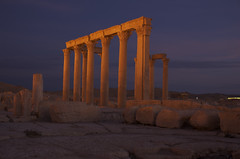A part of my current summer vacation, the one right after the road trip through Ontario and Québec has just fallen through, and I'm not in the best of moods. But since we're having the first relaxed evening since touching down in Canada a week an a half earlier, I thought I sit down and summarize my impressions of Québec. So here it goes:
Montréal was our first encounter with Québec and, oh my, was I impressed. The town has some lovely parts. On the Plateau, near the Mont Royal, the major streets are filled with cafés, restaurants, bars and quirky shops. The sidewalks are full of people as if one were in Europe, and even strolling through residential back streets I didn't get the feeling that everyone passing by was staring at me to judge whether I was a dangerous criminal looking for a heist or a vagrant looking for trouble. Montréal is made for walking.
Montréal is also made for public transport. Four underground lines make is easy to get around quickly, and frequent buses crisscross the area between the métro stops. The majority of the people in the streets speak French but there are also many anglophones and almost everyone seems to understand both languages. I was wondering if there is another city in the world that is equally bilingual but couldn't cone up with one.
Montréal is technically an island – it is completely surrounded by water. How that came to pass geologically is another thing I don't know, but I can tell you that the effect is rather pleasant. The city's main waterfront is just off Old Montréal, a neighborhood that has been retouched nicely over the last decades. In contrast to less fortunate cities where gentrification has been driven to complete Disneylandification, where not a brick is original and most structures look like the shrink wrap has only been removed that same morning, Vieux Montréal and the waterfront are still visibly old. Windows are still rickety and walls crooked, and an enormous rusty ship is moored in full view in one of the docks.
But the best part about the waterfront is a gigantic ugly cement factory that sits on an island in the St. Lawrence, just off the shore. It is massive, it is hideous, and it blocks the view, but I totally loved it. Most places try to look the same these days, most try to be perfect and end up looking bland and interchangeable. The cement factory added a big dollop of past that was so real that you could touch it. It anchored the waterfront firmly in the context of the past and reminded everyone of what we owe our prosperity to – dirty, grimy industry.
Québec City is advertised as the only walled city in North American and as a place where you can forget that you are in America. It's true. The city is really different. The roads in the fortified part of town are narrow, twisted and studded with curbside cafés and restaurants. French is spoken universally. All buildings are old and full of history. A vibe of relaxed savoir-vivre lay in the air.
On the other hand, it also felt like all the tourist traps of Paris were packed inside the thick walls. Busloads of day trippers thronged alleyways stuffed with cheap oil paintings of the Château Frontenac and the Séminaire de Québec, bad street musicians played until you paid them to harass someone else, and caricaturists were like vultures with pencils. After a brisk walk covering most of the upper old town, I had only found the large boardwalk-like terrace overlooking the St. Lawrence charming. The rest – for the bin.
Luckily, we discovered later that Québec continues beyond its walls. Out there, there are similar cafés and restaurants and plenty of narrow streets but fewer tourists. It was on a walk through the back streets that we discovered the lovely waterfront that, just like Montréal's, has recently been redeveloped. Amazingly, it also has a cement factory that looks out of place and blocks the view but adds context and originality. Canada surely is different.

No comments:
Post a Comment